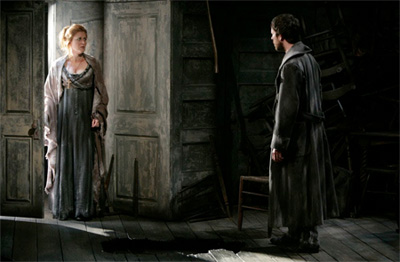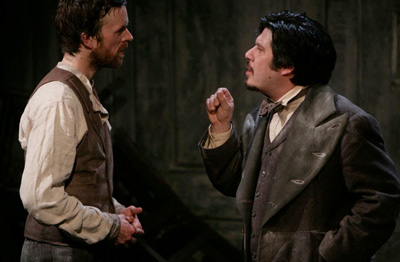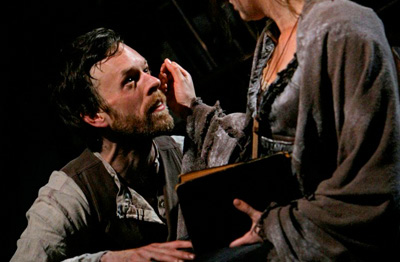Introduction and Overview
In 1866 the Russian novelist Fyodor Dostoevsky published Crime
and Punishment, one of his greatest novels. It's a penetrating study
of the psychology of sin, guilt, and redemption, and it haunts the reader long
after the final page has been read. It tells the story of an intelligent, but
impoverished, young Russian intellectual named Raskolnikov. Under the
unfortunate influence of a particularly pernicious theory of society and human
nature, he exalts himself above the moral law, grievously transgresses it by
committing two murders, "and plunges into a hell of persecution, madness and
terror."{1}
Raskolnikov had conceived of himself as a great and
extraordinary man, on the order of a Napoleon. He tried to convince himself
that he wasn't bound by the same tired old moral code that the vast mass of
humanity lives in recognition of, if not obedience to--the merely ordinary men and women who accomplish little and amount to less. Nevertheless, after committing
his horrible crime, he finds that he cannot escape his punishment: he cannot
silence his sensitive and overburdened conscience. In the end, when he can
stand it no longer, he decides to confess his crime and accept suffering as a
means of atonement.
Joseph Frank observes that Dostoevsky, the author of this
story, had "long been preoccupied with the question of crime and conscience."{2} In one of his letters, Dostoevsky describes his story as the "psychological
report of a crime."{3} The crime is committed, he says, by "a young man,
expelled from the university . . . and living in the midst of the direst
poverty." Coming under the influence of "the strange, 'unfinished' ideas that
float in the atmosphere," he decides to murder an old pawnbroker and steal her
money. Dostoevsky describes the old woman as "stupid and ailing," "greedy" and
"evil." Why, it would hardly be a crime at all to murder such a wretched
person! What's more, with the money from his crime, the young man can "finish
his studies, go abroad," and devote the rest of his life to the benefit of
humanity!
Inspired by these thoughts, the young man goes through with
the crime and murders the old woman. But, notes Dostoevsky, "here is where the
entire psychological process of the crime is unfolded. Insoluble problems
confront the murderer, unsuspected and unexpected feelings torment his heart .
. . and he finishes by being forced to denounce himself."
This, in brief, is the story of Crime and Punishment.
In what follows, we'll take a closer look at the theory which led Raskolnikov
to commit his crime. Then we'll consider why the theory proved false when
Raskolnikov actually attempted to put it into practice.
The Ordinary and Extraordinary
Raskolnikov committed two murders, in part simply to see if
he really has the bravado to put his theories into practice. But what are these
ideas? Where do they come from? And why do they lead Raskolnikov to such
heinous actions?
Essentially, Raskolnikov's theory, which was partially
developed in an article on crime that he had written, holds that all men, by a kind
of law of nature, are divided into two distinct classes: the ordinary and the extraordinary. This theory, which finds some of its philosophical
roots in the writings of men like Hegel and Nietzsche, claims that ordinary men
exist merely for the purpose of reproduction by which, at length, the
occasional, extraordinary man might arise. Raskolnikov declares, "The vast mass
of mankind is mere material, and only exists in order by some great effort, by some
mysterious process, by means of some crossing of races and stocks, to bring
into the world at last perhaps one man out of a thousand with a spark of
independence." The man of genius is rarer still, "and the great geniuses, the
crown of humanity, appear on earth perhaps one in many thousand millions."{4}
The distinctive features of the ordinary man are a
conservative temperament and a law-abiding disposition. But extraordinary men
"all transgress the law." Indeed, says Raskolnikov, "if such a one is forced
for the sake of his idea to step over a corpse or wade through blood, he can .
. . find . . . in his own conscience, a sanction for wading through blood."{5} So
the extraordinary man has the right--indeed, depending on the value of his
ideas, he may even have the duty--to destroy those who stand in his way. After
all, Raskolnikov observes, such ideas may benefit "the whole of humanity."{6} But
how can we know if we are merely ordinary men, or whether, perhaps, we are extraordinary?
How can we know if we have the right to transgress the law to achieve our
own ends?
Raskolnikov admits that confusion regarding one's class is
indeed possible. But he thinks "the mistake can only arise . . . among the
ordinary people" who sometimes like to imagine themselves more advanced than
they really are. And we needn't worry much about that, for such people are
"very conscientious" and will impose "public acts of penitence upon themselves
with a beautiful and edifying effect."{7}
But as we'll see, it's one of the ironies of this novel that
Raskolnikov, who committed murder because he thought himself extraordinary,
made precisely this tragic mistake.
A Walking Contradiction
James Roberts observes that Raskolnikov "is best seen as two
characters. He sometimes acts in one manner and then suddenly in a manner
completely contradictory."{8} Evidence for this can be seen throughout the
novel. In this way, Dostoevsky makes clear, right from the beginning of his story,
that Raskolnikov is not an extraordinary man, at least not in the sense
in which Raskolnikov himself uses that term in his theory of human nature.
In the opening pages of the novel, we see Raskolnikov at war
with himself as he debates his intention to murder an old pawnbroker. "I want
to attempt a thing like that," he says to himself.{9} Then, after
visiting the old woman's flat, ostensibly to pawn a watch, but in reality as a
sort of "dress rehearsal" for the murder, he again questions himself: "How
could such an atrocious thing come into my head? What filthy things my heart is
capable of. Yes, filthy above all . . . loathsome!"{10}
This inner battle suggests that Raskolnikov has mistaken
himself for an extraordinary man, a man bound neither by the rules of
society, nor the higher moral law. But in fact, he's actually just a conscientious ordinary man. The portrait Dostoevsky paints of him is really quite
complex. He often appears to be a sensitive, though confused, young
intellectual, who's been led to entertain his wild ideas more as a result of
dire poverty and self-imposed isolation from his fellow man, rather than from sheer
malice or selfish ambition.
In fear and trembling he commits two murders, partly out of
a confused desire to thereby benefit the rest of humanity, and partly out of a
seemingly genuine concern to really live in accordance with his theories. Ironically,
while the murders are partly committed with the idea of taking the old
pawnbroker's money to advance Raskolnikov's plans, he never attempts to use the
money, but merely buries it under a stone. What's more, Raskolnikov is
portrayed as one of the more generous characters in the novel. On more than one
occasion, he literally gives away all the money he has to help meet the needs
of others. Finally, while Raskolnikov is helped toward confessing his crime
through the varied efforts of Porfiry Petrovich, the brilliant, yet
compassionate, criminal investigator, and Sonia, the humble, selfless
prostitute, nevertheless, it's primarily Raskolnikov's own tormented conscience
that, at length, virtually forces him to confess to the murders.
So while Raskolnikov is guilty, he's not completely lost. He
still retains a conscience, as well as some degree of genuine compassion toward
others. Dostoevsky wants us to see that there's still hope for Raskolnikov!
The Hope of Restoration
After Raskolnikov commits the two murders, he finds himself
confronted with the desperate need to be reconciled with God and his fellow
man. From the beginning of the story, Raskolnikov is portrayed as somewhat
alienated from his fellows. But once he commits the murders, he experiences a
decisive break, both spiritually and psychologically, from the rest of
humanity. Indeed, when he murders the old pawnbroker and her sister, something
within Raskolnikov also dies. The bond that unites him with all other men in a
common humanity is destroyed--or "dies"--as a sort of poetic justice for
murdering the two women.
This death, which separates Raskolnikov both from God and
his fellow man, can only be reversed through a miracle of divine grace and
power. In the novel, the biblical paradigm for this great miracle is the story
of the raising of Lazarus. Just as Lazarus died, and was then restored to life
through the miraculous power of God in Christ, so also, in Dostoevsky's story,
Raskolnikov's "death" is neither permanent nor irreversible. He too can be
"restored to life." He too can be reconciled with God and man.
While this theme of death and restoration to life is
somewhat subtle, nevertheless, Dostoevsky probably intended it as one of the
primary themes of the novel. In the first place, it is emphasized by Sonia,
Porfiry Petrovich, and Raskolnikov's own sister, that only by confessing his
crime and accepting his punishment can Raskolnikov again be restored to
the rest of humanity. In this way, Dostoevsky repeatedly emphasizes the "death"
of Raskolnikov.
In addition, the raising of Lazarus is mentioned at least
three times in the novel. One time is when, in the midst of a heated
discussion, Porfiry specifically asks Raskolnikov if he believes in the raising
of Lazarus, to which Raskolnikov responds that he does.{11} This affirmation
foreshadows some hope for Raskolnikov, for the fact that he believes in this
miracle at least makes possible the belief that God can also work a miracle in
his own life. Secondly, the only extended portion of Scripture cited in the
novel relates the story of Lazarus. In fact, it's Raskolnikov himself,
tormented by what he's done, who asks Sonia to read him the story.{12} Finally,
at the end of the novel, the raising of Lazarus is mentioned yet again, this
time as Raskolnikov recollects Sonia's previous reading of the story to him.{13} Interestingly, this final reference to the raising of Lazarus occurs in the
context of Raskolnikov's own "restoration to life."
Restored to Life
Near the end of the novel, Raskolnikov at last goes to the
police station and confesses to the murders: "It was I killed the old
pawnbroker woman and her sister Lizaveta with an axe and robbed them."{14} He
is sentenced to eight years in a Siberian labor prison. Sonia, true to her
promise, selflessly follows him there. Early one morning she comes to visit
Raskolnikov. Overcome with emotion, he begins weeping and throws himself at her
feet. Sonia is terrified. "But at the same moment she understood . . . . She
knew . . . that he loved her . . . and that at last the moment had come."{15} God's
love, mediated through Sonia, had finally broken through to Raskolnikov: "He
had risen again and he . . . felt in it all his being."{16}
Although Raskolnikov had previously been something of an
outcast with his fellow inmates, nevertheless, on the day of his "restoration,"
his relations with them begin to improve. Dostoevsky writes:
He . . . fancied that day that all
the convicts who had been his enemies looked at him differently; he had even
entered into talk with them and they answered him in a friendly way. He
remembered that now, and thought it was bound to be so. Wasn't everything now
bound to be changed?{17}
What's more, Dostoevsky also implies that Raskolnikov is
being restored to relationship with God. Picking up the New Testament that
Sonia had given him, "one thought passed through his mind: 'Can her convictions
not be mine now? Her feelings, her aspirations at least . . .'"{18} And
Dostoevsky then concludes his great novel by stating: "But that is the
beginning of a new story--the story of the gradual renewal of a man, the story
of his gradual regeneration, of his passing from one world into another, of his
initiation into a new unknown life."{19}
So by the end of the novel, Raskolnikov, as a type of Lazarus,
has experienced his own "restoration to life." He is ready to begin "his
initiation into a new unknown life." And interestingly, the grace which brings
about Raskolnikov's restoration is primarily mediated to him through the quiet,
humble love of Sonia, a prostitute. Just as God was not ashamed to have his own
Son, humanly speaking, descended from some who were murderers and some who were
prostitutes--for it was just such people He came to save--so also, in
Dostoevsky's story, God is not ashamed to extend His forgiveness and grace to a
prostitute, and through her to a murderer as well. Crime and Punishment thus ends on a note of hope, for the guilty can be forgiven and the dead
restored to life!
Notes
- Fyodor Dostoevsky, Crime and Punishment, trans. Constance Garnett (New York: Bantam Books, 1987). Citation from cover blurb on back of book.
- Joseph Frank, "Introduction" to Dostoevsky, Crime and Punishment, ix.
- The citations from Dostoevsky's letter come from Joseph Frank's "Introduction" to Dostoevsky, Crime and Punishment, viii-ix.
- Dostoevsky, Crime and Punishment, 229.
- Ibid., 227.
- Ibid., 226.
- Ibid., 228.
- James Roberts, Cliffs Notes on Dostoevsky's Crime and Punishment, ed. Gary Carey (Lincoln, Nebraska: Cliffs Notes, Inc.), 70.
- Dostoevsky, Crime and Punishment, 2.
- Ibid., 7.
- Ibid., 227.
- Ibid., 283.
- Ibid., 472.
- Ibid., 458.
- Ibid., 471.
- Ibid.
- Ibid.
- Ibid., 472.
- Ibid.









